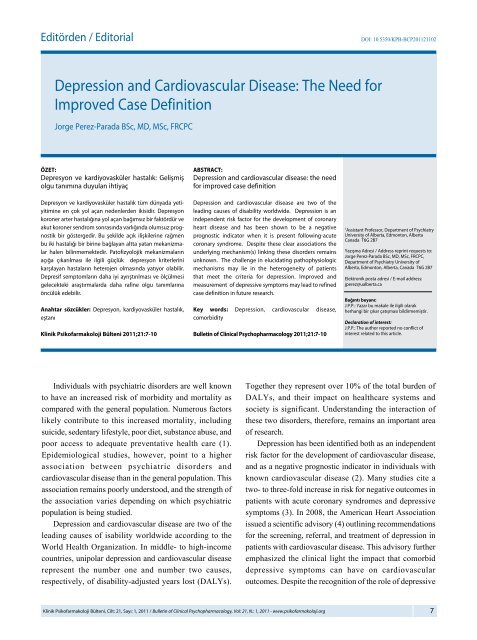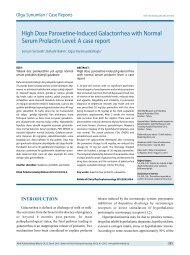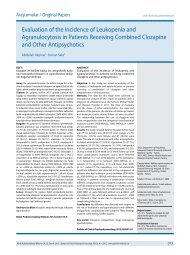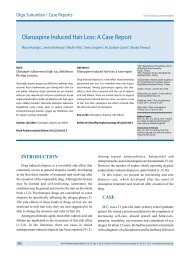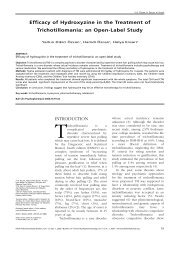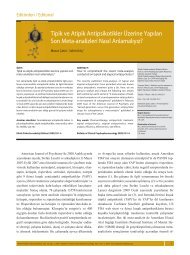Depression and Cardiovascular Disease: The Need for Improved ...
Depression and Cardiovascular Disease: The Need for Improved ...
Depression and Cardiovascular Disease: The Need for Improved ...
You also want an ePaper? Increase the reach of your titles
YUMPU automatically turns print PDFs into web optimized ePapers that Google loves.
Editörden / Editorial<br />
<strong>Depression</strong> <strong>and</strong> <strong>Cardiovascular</strong> <strong>Disease</strong>: <strong>The</strong> <strong>Need</strong> <strong>for</strong><br />
<strong>Improved</strong> Case Definition<br />
Jorge Perez-Parada BSc, MD, MSc, FRCPC<br />
ÖZET:<br />
Depresyon ve kardiyovasküler hastalık: Gelişmiş<br />
olgu tanımına duyulan ihtiyaç<br />
Depresyon ve kardiyovasküler hastalık tüm dünyada yetiyitimine<br />
en çok yol açan nedenlerden ikisidir. Depresyon<br />
koroner arter hastalığına yol açan bağımsız bir faktördür ve<br />
akut koroner sendrom sonrasında varlığında olumsuz prognostik<br />
bir göstergedir. Bu şekilde açık ilişkilerine rağmen<br />
bu iki hastalığı bir birine bağlayan altta yatan mekanizmalar<br />
halen bilinmemektedir. Patofizyolojik mekanizmaların<br />
açığa çıkarılması ile ilgili güçlük depresyon kriterlerini<br />
karşılayan hastaların heterojen olmasında yatıyor olabilir.<br />
Depresif semptomların daha iyi ayrıştırılması ve ölçülmesi<br />
gelecekteki araştırmalarda daha rafine olgu tanımlarına<br />
öncülük edebilir.<br />
Anahtar sözcükler: Depresyon, kardiyovasküler hastalık,<br />
eştanı<br />
Kli nik Psi ko far ma ko lo ji Bül te ni 2011;21:7-10<br />
Individuals with psychiatric disorders are well known<br />
to have an increased risk of morbidity <strong>and</strong> mortality as<br />
compared with the general population. Numerous factors<br />
likely contribute to this increased mortality, including<br />
suicide, sedentary lifestyle, poor diet, substance abuse, <strong>and</strong><br />
poor access to adequate preventative health care (1).<br />
Epidemiological studies, however, point to a higher<br />
association between psychiatric disorders <strong>and</strong><br />
cardiovascular disease than in the general population. This<br />
association remains poorly understood, <strong>and</strong> the strength of<br />
the association varies depending on which psychiatric<br />
population is being studied.<br />
<strong>Depression</strong> <strong>and</strong> cardiovascular disease are two of the<br />
leading causes of isability worldwide according to the<br />
World Health Organization. In middle- to high-income<br />
countries, unipolar depression <strong>and</strong> cardiovascular disease<br />
represent the number one <strong>and</strong> number two causes,<br />
respectively, of disability-adjusted years lost (DALYs).<br />
ABS TRACT:<br />
<strong>Depression</strong> <strong>and</strong> cardiovascular disease: the need<br />
<strong>for</strong> improved case definition<br />
<strong>Depression</strong> <strong>and</strong> cardiovascular disease are two of the<br />
leading causes of disability worldwide. <strong>Depression</strong> is an<br />
independent risk factor <strong>for</strong> the development of coronary<br />
heart disease <strong>and</strong> has been shown to be a negative<br />
prognostic indicator when it is present following-acute<br />
coronary syndrome. Despite these clear associations the<br />
underlying mechanism(s) linking these disorders remains<br />
unknown. <strong>The</strong> challenge in elucidating pathophysiologic<br />
mechanisms may lie in the heterogeneity of patients<br />
that meet the criteria <strong>for</strong> depression. <strong>Improved</strong> <strong>and</strong><br />
measurement of depressive symptoms may lead to refined<br />
case definition in future research.<br />
Key words: <strong>Depression</strong>, cardiovascular disease,<br />
comorbidity<br />
Bulletin of Clinical Psychopharmacology 2011;21:7-10<br />
Klinik Psikofarmakoloji Bülteni, Cilt: 21, Sayı: 1, 2011 / Bulletin of Clinical Psychopharmacology, Vol: 21, N.: 1, 2011 - www.psikofarmakoloji.org<br />
DOI: 10.5350/KPB-BCP201121102<br />
1Assistant Professor, Department of Psychiatry<br />
University of Alberta, Edmonton, Alberta<br />
Canada T6G 2B7<br />
Ya zış ma Ad re si / Add ress rep rint re qu ests to:<br />
Jorge Perez-Parada BSc, MD, MSc, FRCPC,<br />
Department of Psychiatry University of<br />
Alberta, Edmonton, Alberta, Canada T6G 2B7<br />
Elekt ro nik pos ta ad re si / E-ma il add ress:<br />
jperez@ualberta.ca<br />
Bağıntı beyanı:<br />
J.P.P.: Yazar bu makale ile ilgili olarak<br />
herhangi bir çıkar çatışması bildirmemiştir.<br />
Declaration of interest:<br />
J.P.P.: <strong>The</strong> author reported no conflict of<br />
interest related to this article.<br />
Together they represent over 10% of the total burden of<br />
DALYs, <strong>and</strong> their impact on healthcare systems <strong>and</strong><br />
society is significant. Underst<strong>and</strong>ing the interaction of<br />
these two disorders, there<strong>for</strong>e, remains an important area<br />
of research.<br />
<strong>Depression</strong> has been identified both as an independent<br />
risk factor <strong>for</strong> the development of cardiovascular disease,<br />
<strong>and</strong> as a negative prognostic indicator in individuals with<br />
known cardiovascular disease (2). Many studies cite a<br />
two- to three-fold increase in risk <strong>for</strong> negative outcomes in<br />
patients with acute coronary syndromes <strong>and</strong> depressive<br />
symptoms (3). In 2008, the American Heart Association<br />
issued a scientific advisory (4) outlining recommendations<br />
<strong>for</strong> the screening, referral, <strong>and</strong> treatment of depression in<br />
patients with cardiovascular disease. This advisory further<br />
emphasized the clinical light the impact that comorbid<br />
depressive symptoms can have on cardiovascular<br />
outcomes. Despite the recognition of the role of depressive<br />
7
<strong>Depression</strong> <strong>and</strong> cardiovascular diseases: the need <strong>for</strong> improved case definition<br />
symptoms in poorer cardiovascular outcomes, there is<br />
insufficient evidence in the literature that treatment of<br />
depressive symptoms alters cardiovascular outcomes.<br />
In the SADHART study, Glassman et al. (5) evaluated<br />
the safety <strong>and</strong> efficacy of the use of sertraline on patients<br />
admitted to hospital <strong>for</strong> recent myocardial infarction or<br />
unstable angina with major depression. Although they<br />
were able to demonstrate that the use of sertraline was safe<br />
in this population, there were not statistically significant<br />
decreases in Hamilton <strong>Depression</strong> (HAM-D) scores in<br />
sertraline-treated patients as compared to placebo. Subgroup<br />
analysis did demonstrate that patients with a<br />
previous history of depression showed a statistically<br />
significant response to sertraline. When they compared the<br />
incidence of severe cardiovascular events in the sertralinetreated<br />
group (14.5%) versus the placebo group (22.4%)<br />
they were unable to find statistical significance. So<br />
although sertraline was effective in treating depressive<br />
symptoms in a recurrent depression sub-group post<br />
myocardial infarct, they were unable to show an impact<br />
between groups in cardiovascular outcomes.<br />
<strong>The</strong> ENRICHD study (6) compared a cognitive<br />
behavioural therapy (CBT) intervention in patients<br />
admitted with acute myocardial infarction who fulfilled<br />
criteria <strong>for</strong> major or minor depression or low perceived<br />
social support as compared to a usual care group. A total<br />
of 2,481 subjects were r<strong>and</strong>omized to either the CBT<br />
intervention or usual care group. Within the intervention<br />
group, if patients had scores on the Hamilton Rating Scale<br />
<strong>for</strong> <strong>Depression</strong> (HAM-D) greater than 24 or failed to have<br />
a 50% reduction in Beck <strong>Depression</strong> Inventory (BDI)<br />
scores after five weeks of intervention, they were referred<br />
<strong>for</strong> consideration of antidepressant add-on treatment<br />
(sertraline>other SSRIs>nortriptyline). Antidepressant<br />
use reached 20.6% <strong>and</strong> 28% in the usual care <strong>and</strong><br />
intervention groups respectively. Although the intervention<br />
in this study decreased depressive symptoms <strong>and</strong> improved<br />
social support as compared to the usual care group, it did<br />
not affect the primary end points of death <strong>and</strong> non-fatal<br />
myocardial infarction. <strong>The</strong> trend was again to see a<br />
reduction in reinfarction <strong>and</strong> mortality in patients on<br />
antidepressant therapy. <strong>The</strong> authors, however, concluded<br />
that given their design study this finding may have been<br />
related to a pharmacodynamic effect of SSRIs, such as<br />
platelet inhibition, rather than to an improvement in<br />
depressive symptoms.<br />
Honig et al. (7) opted to study the effects of a dual<br />
acting antidepressant, mirtazapine, to evaluate its safety<br />
<strong>and</strong> efficacy in depressed patients post-myocardial<br />
infarction. Ninety-one patients who met criteria <strong>for</strong> major<br />
or minor depressive disorder were r<strong>and</strong>omized to either<br />
placebo or mirtazapine treatment <strong>and</strong> were followed <strong>for</strong> 24<br />
weeks. Using a last observation carried <strong>for</strong>ward model, the<br />
authors did not find a statistically significant difference in<br />
mirtazapine versus placebo in either the acute phase (8<br />
weeks) or the entire treatment phase (24 weeks) using the<br />
primary measure of reduction in HAM-D score. Statistical<br />
significance was, however, found when the authors<br />
compared the efficacy of mirtazepine on the secondary<br />
outcome measures of scores on the BDI, the depression<br />
subscale of the Symptom Checklist 90(dSCL-90) <strong>and</strong> the<br />
Clinical Global Impression (CGI). Mirtazapine was also<br />
shown to be safe in this post-myocardial infarction<br />
population, although, as in the SADHART study,<br />
medications were not prescribed until 3 months after the<br />
incident event. <strong>The</strong> authors speculate that including major<br />
<strong>and</strong> minor depression may have influenced the statistical<br />
significance of their findings on their primary outcome<br />
measure. This reflects one of the major limitations in most<br />
of the depression <strong>and</strong> cardiovascular literature, which is<br />
that the operational <strong>and</strong> inclusion criteria <strong>for</strong> defining <strong>and</strong><br />
measuring depression <strong>and</strong> depressive symptoms are<br />
inconsistent. It is plausible that the rating scales used as<br />
outcome measures are distinct in how they identify <strong>and</strong><br />
track depressive symptoms post acute coronary syndrome.<br />
<strong>The</strong>re is some debate as to why depressive symptoms<br />
post-myocardial infarction do not respond to antidepressant<br />
therapy or psychological intervention as expected when<br />
compared to a “healthy” depression population. <strong>The</strong>re<br />
seems to be some distinction in response between patients<br />
with a previous history of major depressive disorder <strong>and</strong><br />
patients who develop incident depressive symptoms post<br />
myocardial infarction (8). Similarly, the failure to show,<br />
that treating depressive symptoms improves cardiovascular<br />
outcomes promotes reflection on the etiology <strong>and</strong> biologic<br />
underpinnings of these depressive symptoms. One of the<br />
challenges in studying underlying pathophysiologic<br />
mechanisms lies in the inherent heterogeneity of subjects<br />
who meet the DSM-IV criteria <strong>for</strong> major depressive<br />
disorder. Patients meeting the criteria <strong>for</strong> depression often<br />
have a wide variance in symptom severity <strong>and</strong> symptom<br />
expression that likely represents important sub-types.<br />
8 Klinik Psikofarmakoloji Bülteni, Cilt: 21, Sayı: 1, 2011 / Bulletin of Clinical Psychopharmacology, Vol: 21, N.: 1, 2011 - www.psikofarmakoloji.org
Furthermore, the presence of co-morbid syndromes such<br />
as anxiety may play a significant role. <strong>The</strong> literature<br />
linking anxiety spectrum disorders <strong>and</strong> phobic anxiety to<br />
adverse cardiovascular outcomes is almost as extensive as<br />
that of depression (9). Does this mean that each separate<br />
psychiatric diagnosis that has been linked to the<br />
development or progression of cardiovascular disease is<br />
operating via a mutually exclusive mechanism?<br />
More recent studies have begun to try to identify the<br />
key component(s) of depressive symptoms that confre(s)<br />
the cardiotoxic effect(s) (10). <strong>The</strong> worldwide genome<br />
project has lead to much excitement in trying to identify<br />
c<strong>and</strong>idate genes <strong>for</strong> a number of psychiatric disorders. In a<br />
review article, Hasler et al. (11) describe a number of<br />
potential phenotypes of depression <strong>and</strong> potential<br />
biomarkers that may lead to the discovery of<br />
endophenotypes that may aid researchers in refining<br />
criteria <strong>for</strong> the complex syndrome that is presently termed<br />
depression.<br />
In this vein, two recent studies have begun to identify<br />
important elements or symptoms of depression that are<br />
more clearly identified with negative cardiovascular<br />
outcomes. Hoen et al. (12) looked at the relationship<br />
between cognitive <strong>and</strong> somatic depressive symptoms <strong>and</strong><br />
cardiovascular outcomes in outpatients with stable<br />
coronary heart disease. <strong>The</strong> 9-item Patient Health<br />
Questionnaire was administered to 1,019 patients with<br />
stable heart disease to determine the presence <strong>and</strong> severity<br />
of depressive symptoms as outlined in the DSM-IV.<br />
Depressive symptoms categorized as primarily cognitive<br />
were depressed mood, lack of interest, worthlessness,<br />
concentration difficulties <strong>and</strong> suicidal ideation. Depressive<br />
symptoms categorized as somatic were challenges with<br />
appetite, sleeping difficulties, psychomotor changes <strong>and</strong><br />
fatigue. Patients were followed with annual phone calls to<br />
determine if there were any deaths or hospitalizations <strong>for</strong><br />
“heart trouble”. Chart reviews were conducted <strong>for</strong> any<br />
patient with an adverse cardiovascular event. <strong>The</strong> outcome<br />
measures were cardiovascular events including heart<br />
failure, myocardial infarction, stroke, transient ischemic<br />
attack or death. In age-adjusted analyses both somatic <strong>and</strong><br />
cognitive symptoms were associated with an increased<br />
risk <strong>for</strong> cardiovascular events (21% <strong>and</strong> 12% respectively).<br />
Once this data was adjusted <strong>for</strong> confounding variables the<br />
cognitive sum score did not significantly predict<br />
cardiovascular events. <strong>The</strong> somatic symptoms of sleeping<br />
Klinik Psikofarmakoloji Bülteni, Cilt: 21, Sayı: 1, 2011 / Bulletin of Clinical Psychopharmacology, Vol: 21, N.: 1, 2011 - www.psikofarmakoloji.org<br />
J. Perez-Parada<br />
difficulties, fatigue <strong>and</strong> appetite problems were, however,<br />
independently predictive of cardiovascular events after<br />
adjustment <strong>for</strong> age, sex, diabetes, history of myocardial<br />
infarction, history of heart failure, left ventricular ejection<br />
fraction, body mass index, smoking <strong>and</strong> use of<br />
cardioprotective agents. It may be argued that in patients<br />
with coronary heart disease somatic symptoms such as<br />
fatigue, sleeping difficulties <strong>and</strong> psychomotor slowing<br />
merely reflect an increased severity of heart disease at<br />
baseline. <strong>The</strong> authors attempted to correct <strong>for</strong> this by using<br />
a stable outpatient population <strong>and</strong> correcting <strong>for</strong><br />
confounding factors. <strong>The</strong>y argue that a focus on treatment<br />
of the somatic symptoms identified may lead to improved<br />
cardiovascular outcomes. <strong>The</strong> authors, however,<br />
acknowledge that a further underst<strong>and</strong>ing of how the<br />
mechanisms of sleep disturbance, changes in appetite <strong>and</strong><br />
psychomotor abnormalities lead to worsening<br />
cardiovascular prognosis is crucial <strong>for</strong> the design of future<br />
trials.<br />
Davidson et al. (10) used an observational cohort study<br />
design to determine if one of two core diagnostic criteria<br />
of depression, i.e. depressed mood or anhedonia, predicts<br />
one-year medical outcomes <strong>for</strong> patients with acute<br />
coronary syndromes. <strong>The</strong>y looked at 453 consecutive<br />
patients with an acute coronary syndrome admitted to one<br />
of three hospitals. Patients underwent a semi-structured<br />
interview to determine criteria <strong>for</strong> a major depressive<br />
episode, <strong>and</strong> the BDI was used to assess depressed mood<br />
<strong>and</strong> anhedonia. Using these measures, 48 patients met the<br />
criteria <strong>for</strong> major depressive disorder, 108 were rated as<br />
having depressed mood <strong>and</strong> 77 were rated as having<br />
anhedonia. <strong>The</strong> primary end point of the study was either<br />
the first occurrence of a major adverse cardiac event or allcause<br />
mortality at twelve months. Both depressed mood<br />
<strong>and</strong> anhedonia predicted major adverse cardiac events <strong>and</strong><br />
all-cause mortality in an age-adjusted model, however,<br />
only anhedonia remained as a significant predictor <strong>for</strong><br />
adverse cardiovascular outcome after adjusting <strong>for</strong> age,<br />
sex <strong>and</strong> medical covariates. Anhedonia remained a<br />
significant predictor after adjusting <strong>for</strong> major depressive<br />
disorder <strong>and</strong> severity of depressive symptoms.<br />
It is postulated that depressed mood <strong>and</strong> anhedonia (13)<br />
may represent distinct biologic pathophysiologies, <strong>and</strong><br />
there<strong>for</strong>e may help distinguish whether one entity is more<br />
predictive in cardiovascular disease. Anhedonia in<br />
particular has some overlap with somatic symptoms<br />
9
<strong>Depression</strong> <strong>and</strong> cardiovascular diseases: the need <strong>for</strong> improved case definition<br />
including sleep, appetite, weight gain, satisfaction <strong>and</strong><br />
libido. Hasler et al. (11) describe anhedonia as more closely<br />
associated with catecholaminergic dysfunction as opposed<br />
to serotonergic dysfunction, which is linked more closely<br />
to depressed mood. <strong>The</strong> identification of correlations<br />
between anhedonia <strong>and</strong> the somatic symptoms of depression<br />
may also allow <strong>for</strong> further study into their mechanisms.<br />
Linking the identification of sub-types of depression with<br />
potential biological markers such as platelet reactivity<br />
(14,15), heart rate variability (16), REM sleep patterns (11)<br />
<strong>and</strong> endothelial function (17) may lead to a further<br />
underst<strong>and</strong>ing of the complex relationship between<br />
References:<br />
1. Ruschena D, Mullen PE, Burgess P, Cordner SM, Barry-Walsh J,<br />
Drummer OH, Palmer S, Browne C, Wallace C. Sudden death in<br />
psychiatric patients. Br J Psychiatry 1998;172: 331-336.<br />
2. Frasure-Smith <strong>and</strong> Lesperance F. Reflections on depression as a<br />
cardiac risk factor. Psychosom Med 2005;67(suppl 1): S19-25.<br />
3. Barth J, Schumacher M, Hermann-Lingen C. <strong>Depression</strong> as a risk<br />
factor <strong>for</strong> mortality in patients with coronary heart disease: a meta<br />
analysis. Psychosom Med 2004;66(6): 802-813.<br />
4. Lichtman JH, Bigger JT, Blumenthal JA, Frasure-Smith N, Kaufmann<br />
PG, Lesperance F, Mark DB, Sheps DS, Taylor B, Froelicher ES.<br />
<strong>Depression</strong> <strong>and</strong> coronary heart disease: recommendations <strong>for</strong><br />
screening, referral, <strong>and</strong> treatment. A science advisory <strong>for</strong> the<br />
American Heart Association Prevention Committee of the Council<br />
on <strong>Cardiovascular</strong> Nursing, Council on Clinical Cardiology, Council<br />
on Epidemiology <strong>and</strong> Prevention, <strong>and</strong> Interdisciplinary Council on<br />
Quality of Care <strong>and</strong> Outcomes Research; endorsed by the American<br />
Psychiatric Association. Circulation 2008;118: 1768-1775.<br />
5. Glassman AH, O’ Connor CM, Califf RM, Swedberg K, Schwartz<br />
P, Bigger JT Jr, Krishnan KR, van Zyl LT, Swenson JR, Finkel<br />
MS, L<strong>and</strong>au C, Shapiro PA, Pepine CJ, Mardekian J, Harrison<br />
WM, Barton D, McIvor M. Setraline Antidepressant Heart Attack<br />
R<strong>and</strong>omized Trial (SADHEART) Group. Setraline treatment of<br />
major depression in patients with acute MI or unstable angina.<br />
JAMA 2002;288: 701-709.<br />
6. Berkman LF, Blumenthal J, Burg M, Carney RM, Catellier D,<br />
Cowan MJ, Czajkowski SM, DeBusk R, Hosking J, Jaffe A,<br />
Kaufmann PG, Mitchell P, Norman J, Powell LH, Racyznski JM,<br />
Schneiderman N. Enhancing Recovery in Coronary Heart <strong>Disease</strong><br />
Patients Investigators (ENRICHD). Effects of treating depression<br />
<strong>and</strong> low perceived social support on clinical events after myocardial<br />
infarction: the Enhancing Recovery in Coronary Heart <strong>Disease</strong><br />
Patients (ENRICHD) R<strong>and</strong>omized Trial. JAMA 2003;289(23):<br />
3106-3116.<br />
7. Honig A, Kuyper A, Schene AH, van Melle JP, de Jonge P, Tulner<br />
DM, Schins A, Crijns HJ, Kuijpers PM, Vossen H, Lousberg R,<br />
Ormel J. MIND-IT Investigators. Treatment of post-myocardial<br />
infarction depressive disorder: a r<strong>and</strong>omized, placebo-controlled<br />
trial with mirtazapine. Psychosom Med 2007;69(7): 606-613.<br />
depressive symptoms <strong>and</strong> cardiovascular disease.<br />
<strong>The</strong>re is a wealth of published studies looking at both<br />
etiologic <strong>and</strong> prognostic factors as they relate to depression<br />
<strong>and</strong> cardiovascular disease. Un<strong>for</strong>tunately many of these<br />
studies have significant methodological differences, <strong>and</strong><br />
measures of diagnosis <strong>and</strong> outcome vary immensely, such<br />
that conclusions are difficult to make. It is important to<br />
continue to try <strong>and</strong> refine our case definition <strong>and</strong> develop<br />
improved measures that will allow us to focus on the<br />
common mechanisms that underlie the relationships<br />
between cardiovascular disease, depression <strong>and</strong> psychiatric<br />
pathology in general.<br />
8. de Jonge P, van den Brink RH, Spijkerman TA, Ormel J. Only<br />
incident depressive episodes after myocardial infarction are<br />
associated with new cardiovascular events. J Am Coll Cardiol<br />
2006;48(11): 2204-2208.<br />
9. Kawachi I, Colditz GA, Ascherio A, Rimm EB, Giovannucci E,<br />
Stampfer MJ, Willett WC. Coronary heart disease/myocardial<br />
infarction: prospective study of phobic anxiety <strong>and</strong> the risk of<br />
coronary heart disease in men. Circulation 1994;89: 992-1997.<br />
10. Davidson KW, Burg MM, Kronish IM, Shimbo D, Dettenborn L,<br />
Mehran R, Vorchheimer D, Clemow L, Shwartz JE, Lesperance<br />
F, Rieckmann N. Association of anhedonia with recurrent major<br />
adverse cardiac events <strong>and</strong> mortality 1 year after acute coronary<br />
syndrome. Arch Gen Psy 2010;67(5): 480-488.<br />
11 Hasler G, Drevets WC, Manji HK, Charney DS. Discovery<br />
endophenotypes <strong>for</strong> major depression. Neuropsychopharmacology<br />
2004;29(10): 1765-1781.<br />
12. Hoen PW, Whooley MA, Martens EJ, Na B, van Melle JP, de Jonge<br />
P. Differential associations between specific depressive symptoms<br />
<strong>and</strong> cardiovascular prognosis in patients with stable coronary heart<br />
disease. JACC 2010;56(11): 838-844.<br />
13. Gorwood P. Neurobiological mechanisms of anhedonia. 2008;10(3):<br />
291-299.<br />
14. Zafar MU, Paz-Yepes M, Shimbo D, Vilahur G, Burg MM, Chaplin<br />
W, Fuster V, Davidson KW, Badimon JJ. Anxiety is a better<br />
predictor of platelet reactivity in coronary artery disease patients<br />
than depression. Eur Heart J 2010;31: 1573-1582.<br />
15. Wittstein IL. <strong>Depression</strong>, anxiety <strong>and</strong> platelet reactivity in patients<br />
with coronary heart disease. Eur Heart J 2010;31: 1548-1550.<br />
16. Carney RM, Freedl<strong>and</strong> KE, Veith RC. <strong>Depression</strong>, the autonomic<br />
nervous system, <strong>and</strong> coronary heart disease. Psychosom Med<br />
2005;67(suppl 1): S29-S33.<br />
17. Cooper DC, Milic MS, Tafur JR, Mills PJ, Bardwell WA, Ziegler<br />
MG, Dimsdale JE. Adverse impact of mood on flow-mediated<br />
dilation. Psychosom Med 2010;72: 122-127.<br />
10 Klinik Psikofarmakoloji Bülteni, Cilt: 21, Sayı: 1, 2011 / Bulletin of Clinical Psychopharmacology, Vol: 21, N.: 1, 2011 - www.psikofarmakoloji.org


